Business Analytics Report: Harvest Kitchen Sales, Profit and Revenue
VerifiedAdded on 2020/03/16
|17
|2998
|483
Report
AI Summary
This report presents a business analytics analysis of the Harvest Kitchen, a farm product business. The analysis explores various aspects of the business including the identification of top and worst-selling products, comparison of different payment methods (cash, credit, Visa, MasterCard), and the impact of product location within the shop on sales and profit. It investigates the differences in sales and gross profits across different months and seasons, and also examines the relationship between seasonal changes and rainfall. The report utilizes statistical methods such as descriptive statistics, t-tests, and ANOVA to analyze the provided data, aiming to provide insights that can inform business decisions and improve overall performance. Findings reveal significant differences in sales based on product location, payment methods, and monthly variations, while seasonal sales differences were not significant. The report concludes with recommendations for the business based on these findings.
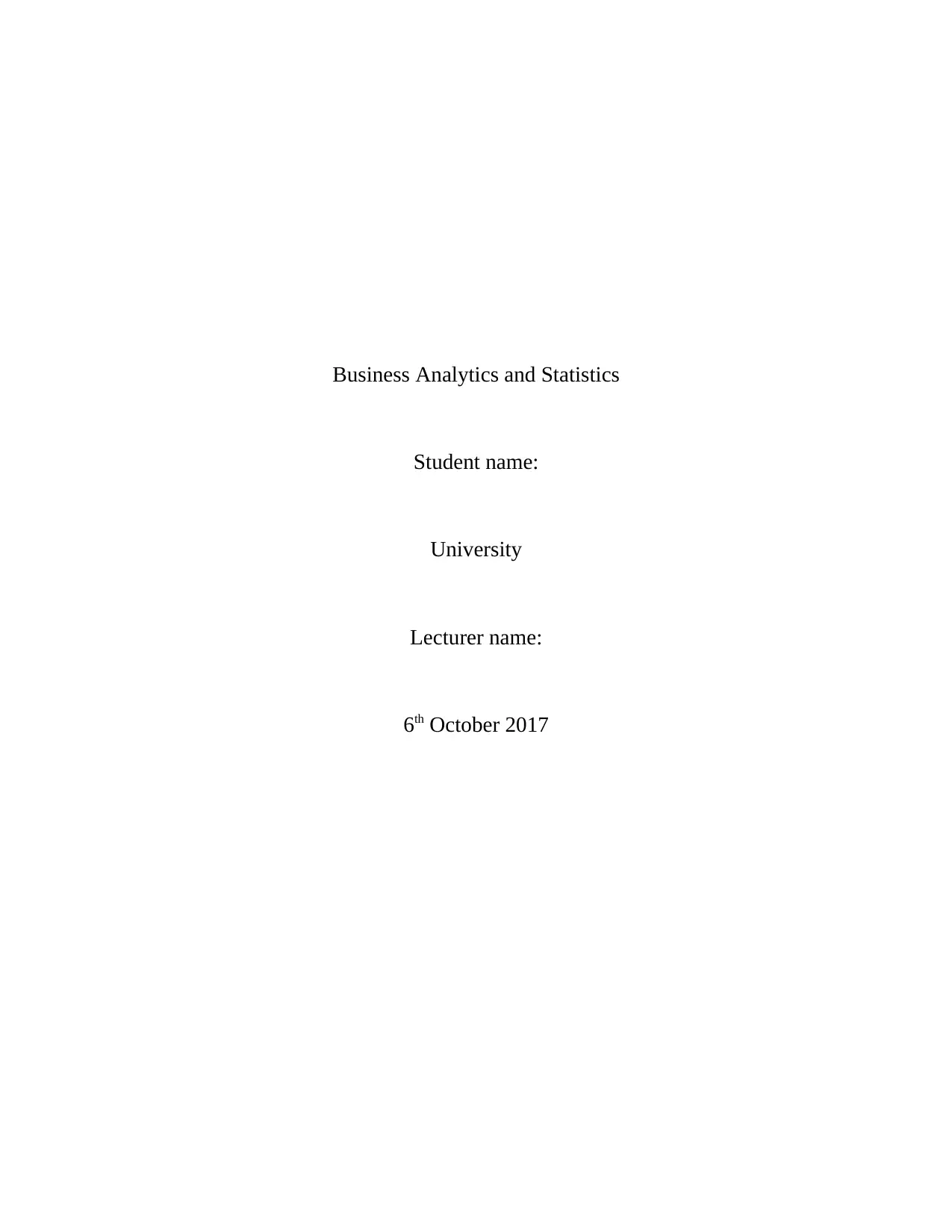
Business Analytics and Statistics
Student name:
University
Lecturer name:
6th October 2017
Student name:
University
Lecturer name:
6th October 2017
Paraphrase This Document
Need a fresh take? Get an instant paraphrase of this document with our AI Paraphraser
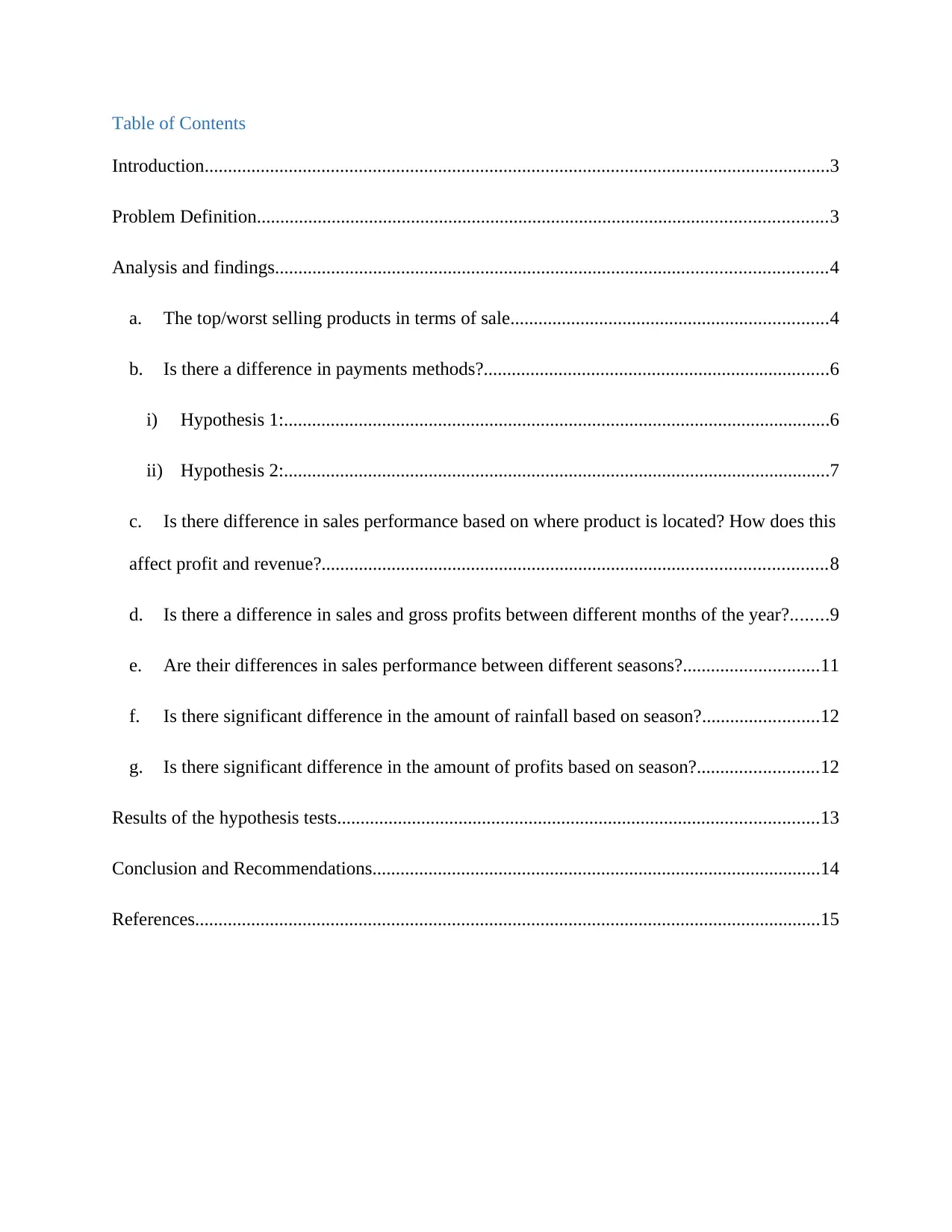
Table of Contents
Introduction......................................................................................................................................3
Problem Definition..........................................................................................................................3
Analysis and findings......................................................................................................................4
a. The top/worst selling products in terms of sale....................................................................4
b. Is there a difference in payments methods?..........................................................................6
i) Hypothesis 1:.....................................................................................................................6
ii) Hypothesis 2:.....................................................................................................................7
c. Is there difference in sales performance based on where product is located? How does this
affect profit and revenue?............................................................................................................8
d. Is there a difference in sales and gross profits between different months of the year?........9
e. Are their differences in sales performance between different seasons?.............................11
f. Is there significant difference in the amount of rainfall based on season?.........................12
g. Is there significant difference in the amount of profits based on season?..........................12
Results of the hypothesis tests.......................................................................................................13
Conclusion and Recommendations................................................................................................14
References......................................................................................................................................15
Introduction......................................................................................................................................3
Problem Definition..........................................................................................................................3
Analysis and findings......................................................................................................................4
a. The top/worst selling products in terms of sale....................................................................4
b. Is there a difference in payments methods?..........................................................................6
i) Hypothesis 1:.....................................................................................................................6
ii) Hypothesis 2:.....................................................................................................................7
c. Is there difference in sales performance based on where product is located? How does this
affect profit and revenue?............................................................................................................8
d. Is there a difference in sales and gross profits between different months of the year?........9
e. Are their differences in sales performance between different seasons?.............................11
f. Is there significant difference in the amount of rainfall based on season?.........................12
g. Is there significant difference in the amount of profits based on season?..........................12
Results of the hypothesis tests.......................................................................................................13
Conclusion and Recommendations................................................................................................14
References......................................................................................................................................15
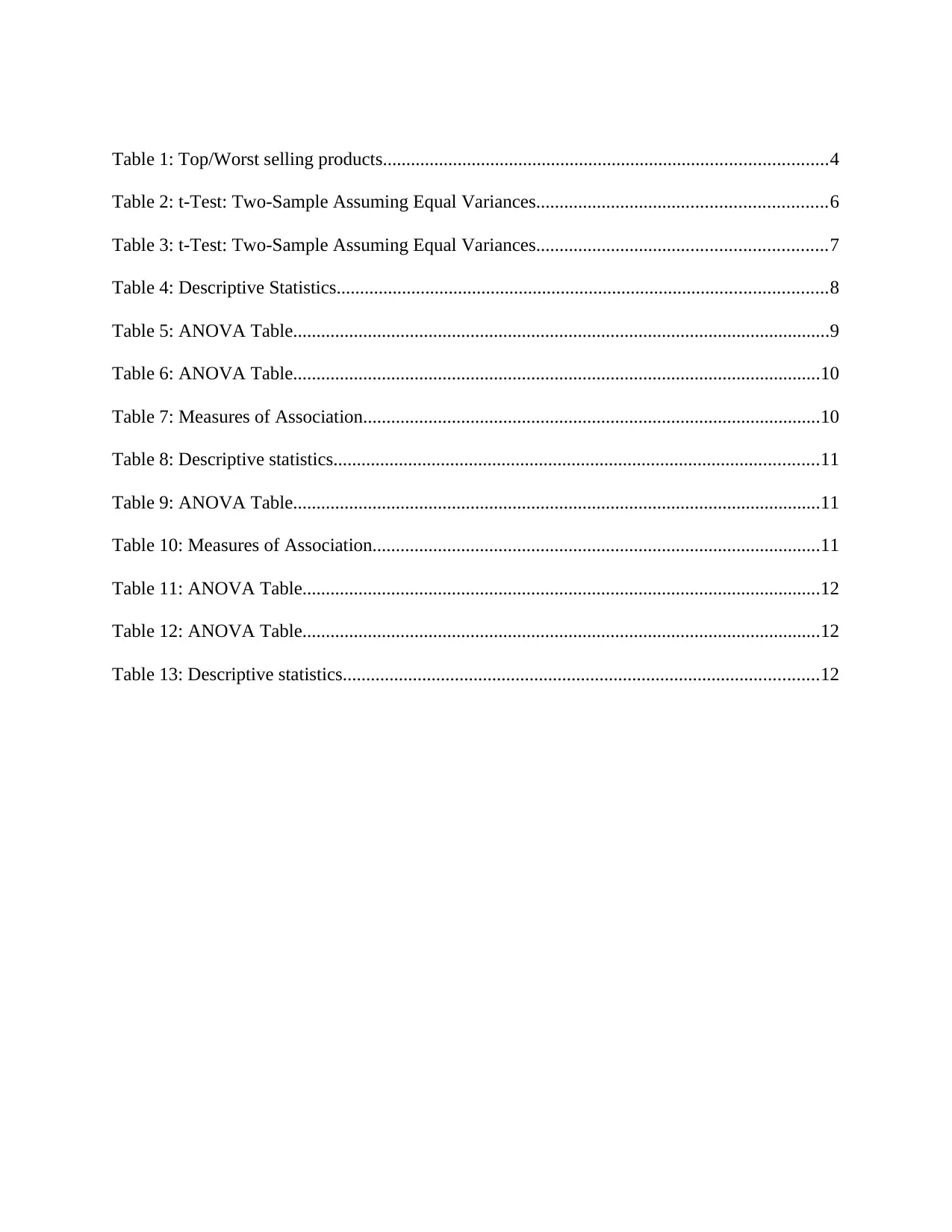
Table 1: Top/Worst selling products...............................................................................................4
Table 2: t-Test: Two-Sample Assuming Equal Variances..............................................................6
Table 3: t-Test: Two-Sample Assuming Equal Variances..............................................................7
Table 4: Descriptive Statistics.........................................................................................................8
Table 5: ANOVA Table...................................................................................................................9
Table 6: ANOVA Table.................................................................................................................10
Table 7: Measures of Association..................................................................................................10
Table 8: Descriptive statistics........................................................................................................11
Table 9: ANOVA Table.................................................................................................................11
Table 10: Measures of Association................................................................................................11
Table 11: ANOVA Table...............................................................................................................12
Table 12: ANOVA Table...............................................................................................................12
Table 13: Descriptive statistics......................................................................................................12
Table 2: t-Test: Two-Sample Assuming Equal Variances..............................................................6
Table 3: t-Test: Two-Sample Assuming Equal Variances..............................................................7
Table 4: Descriptive Statistics.........................................................................................................8
Table 5: ANOVA Table...................................................................................................................9
Table 6: ANOVA Table.................................................................................................................10
Table 7: Measures of Association..................................................................................................10
Table 8: Descriptive statistics........................................................................................................11
Table 9: ANOVA Table.................................................................................................................11
Table 10: Measures of Association................................................................................................11
Table 11: ANOVA Table...............................................................................................................12
Table 12: ANOVA Table...............................................................................................................12
Table 13: Descriptive statistics......................................................................................................12
⊘ This is a preview!⊘
Do you want full access?
Subscribe today to unlock all pages.

Trusted by 1+ million students worldwide
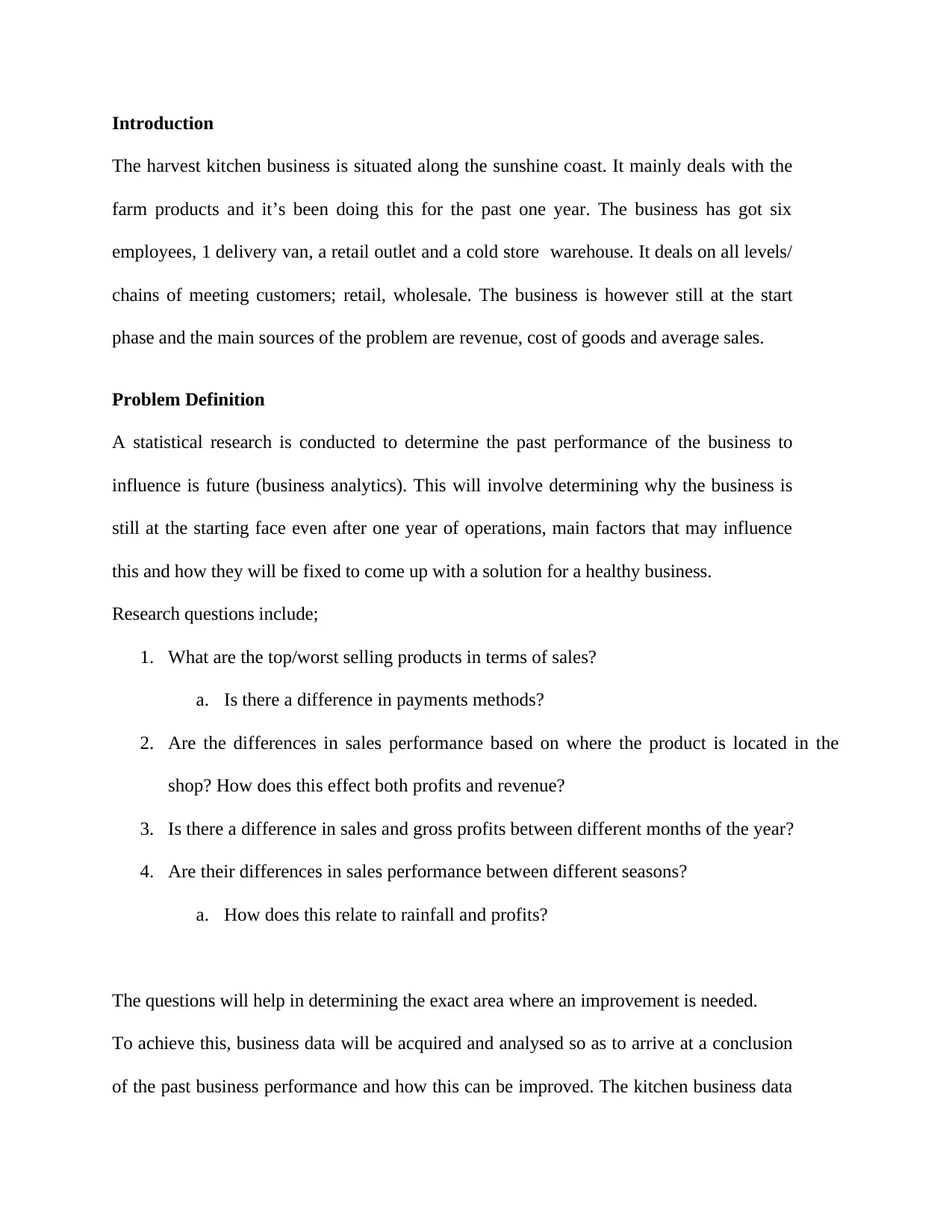
Introduction
The harvest kitchen business is situated along the sunshine coast. It mainly deals with the
farm products and it’s been doing this for the past one year. The business has got six
employees, 1 delivery van, a retail outlet and a cold store warehouse. It deals on all levels/
chains of meeting customers; retail, wholesale. The business is however still at the start
phase and the main sources of the problem are revenue, cost of goods and average sales.
Problem Definition
A statistical research is conducted to determine the past performance of the business to
influence is future (business analytics). This will involve determining why the business is
still at the starting face even after one year of operations, main factors that may influence
this and how they will be fixed to come up with a solution for a healthy business.
Research questions include;
1. What are the top/worst selling products in terms of sales?
a. Is there a difference in payments methods?
2. Are the differences in sales performance based on where the product is located in the
shop? How does this effect both profits and revenue?
3. Is there a difference in sales and gross profits between different months of the year?
4. Are their differences in sales performance between different seasons?
a. How does this relate to rainfall and profits?
The questions will help in determining the exact area where an improvement is needed.
To achieve this, business data will be acquired and analysed so as to arrive at a conclusion
of the past business performance and how this can be improved. The kitchen business data
The harvest kitchen business is situated along the sunshine coast. It mainly deals with the
farm products and it’s been doing this for the past one year. The business has got six
employees, 1 delivery van, a retail outlet and a cold store warehouse. It deals on all levels/
chains of meeting customers; retail, wholesale. The business is however still at the start
phase and the main sources of the problem are revenue, cost of goods and average sales.
Problem Definition
A statistical research is conducted to determine the past performance of the business to
influence is future (business analytics). This will involve determining why the business is
still at the starting face even after one year of operations, main factors that may influence
this and how they will be fixed to come up with a solution for a healthy business.
Research questions include;
1. What are the top/worst selling products in terms of sales?
a. Is there a difference in payments methods?
2. Are the differences in sales performance based on where the product is located in the
shop? How does this effect both profits and revenue?
3. Is there a difference in sales and gross profits between different months of the year?
4. Are their differences in sales performance between different seasons?
a. How does this relate to rainfall and profits?
The questions will help in determining the exact area where an improvement is needed.
To achieve this, business data will be acquired and analysed so as to arrive at a conclusion
of the past business performance and how this can be improved. The kitchen business data
Paraphrase This Document
Need a fresh take? Get an instant paraphrase of this document with our AI Paraphraser
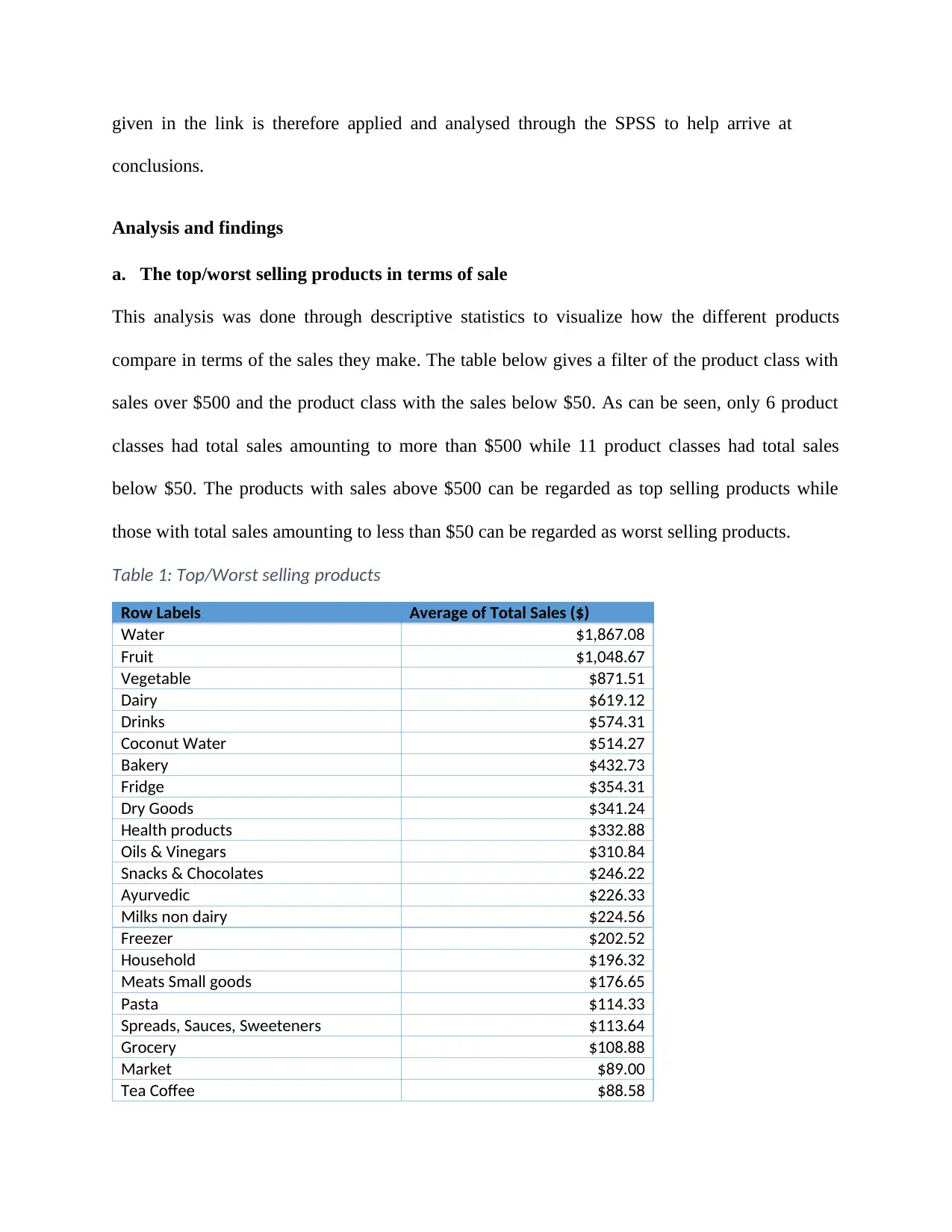
given in the link is therefore applied and analysed through the SPSS to help arrive at
conclusions.
Analysis and findings
a. The top/worst selling products in terms of sale
This analysis was done through descriptive statistics to visualize how the different products
compare in terms of the sales they make. The table below gives a filter of the product class with
sales over $500 and the product class with the sales below $50. As can be seen, only 6 product
classes had total sales amounting to more than $500 while 11 product classes had total sales
below $50. The products with sales above $500 can be regarded as top selling products while
those with total sales amounting to less than $50 can be regarded as worst selling products.
Table 1: Top/Worst selling products
Row Labels Average of Total Sales ($)
Water $1,867.08
Fruit $1,048.67
Vegetable $871.51
Dairy $619.12
Drinks $574.31
Coconut Water $514.27
Bakery $432.73
Fridge $354.31
Dry Goods $341.24
Health products $332.88
Oils & Vinegars $310.84
Snacks & Chocolates $246.22
Ayurvedic $226.33
Milks non dairy $224.56
Freezer $202.52
Household $196.32
Meats Small goods $176.65
Pasta $114.33
Spreads, Sauces, Sweeteners $113.64
Grocery $108.88
Market $89.00
Tea Coffee $88.58
conclusions.
Analysis and findings
a. The top/worst selling products in terms of sale
This analysis was done through descriptive statistics to visualize how the different products
compare in terms of the sales they make. The table below gives a filter of the product class with
sales over $500 and the product class with the sales below $50. As can be seen, only 6 product
classes had total sales amounting to more than $500 while 11 product classes had total sales
below $50. The products with sales above $500 can be regarded as top selling products while
those with total sales amounting to less than $50 can be regarded as worst selling products.
Table 1: Top/Worst selling products
Row Labels Average of Total Sales ($)
Water $1,867.08
Fruit $1,048.67
Vegetable $871.51
Dairy $619.12
Drinks $574.31
Coconut Water $514.27
Bakery $432.73
Fridge $354.31
Dry Goods $341.24
Health products $332.88
Oils & Vinegars $310.84
Snacks & Chocolates $246.22
Ayurvedic $226.33
Milks non dairy $224.56
Freezer $202.52
Household $196.32
Meats Small goods $176.65
Pasta $114.33
Spreads, Sauces, Sweeteners $113.64
Grocery $108.88
Market $89.00
Tea Coffee $88.58
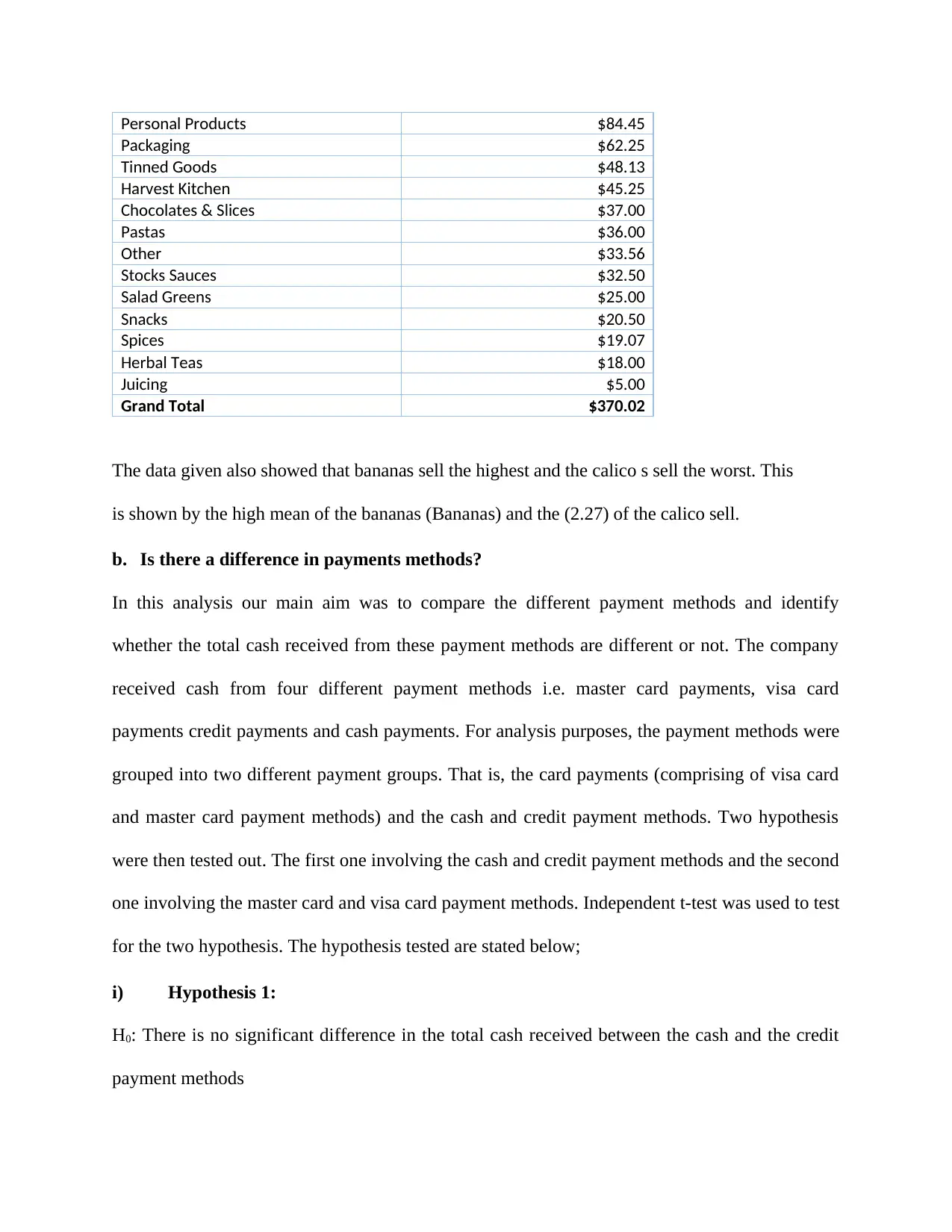
Personal Products $84.45
Packaging $62.25
Tinned Goods $48.13
Harvest Kitchen $45.25
Chocolates & Slices $37.00
Pastas $36.00
Other $33.56
Stocks Sauces $32.50
Salad Greens $25.00
Snacks $20.50
Spices $19.07
Herbal Teas $18.00
Juicing $5.00
Grand Total $370.02
The data given also showed that bananas sell the highest and the calico s sell the worst. This
is shown by the high mean of the bananas (Bananas) and the (2.27) of the calico sell.
b. Is there a difference in payments methods?
In this analysis our main aim was to compare the different payment methods and identify
whether the total cash received from these payment methods are different or not. The company
received cash from four different payment methods i.e. master card payments, visa card
payments credit payments and cash payments. For analysis purposes, the payment methods were
grouped into two different payment groups. That is, the card payments (comprising of visa card
and master card payment methods) and the cash and credit payment methods. Two hypothesis
were then tested out. The first one involving the cash and credit payment methods and the second
one involving the master card and visa card payment methods. Independent t-test was used to test
for the two hypothesis. The hypothesis tested are stated below;
i) Hypothesis 1:
H0: There is no significant difference in the total cash received between the cash and the credit
payment methods
Packaging $62.25
Tinned Goods $48.13
Harvest Kitchen $45.25
Chocolates & Slices $37.00
Pastas $36.00
Other $33.56
Stocks Sauces $32.50
Salad Greens $25.00
Snacks $20.50
Spices $19.07
Herbal Teas $18.00
Juicing $5.00
Grand Total $370.02
The data given also showed that bananas sell the highest and the calico s sell the worst. This
is shown by the high mean of the bananas (Bananas) and the (2.27) of the calico sell.
b. Is there a difference in payments methods?
In this analysis our main aim was to compare the different payment methods and identify
whether the total cash received from these payment methods are different or not. The company
received cash from four different payment methods i.e. master card payments, visa card
payments credit payments and cash payments. For analysis purposes, the payment methods were
grouped into two different payment groups. That is, the card payments (comprising of visa card
and master card payment methods) and the cash and credit payment methods. Two hypothesis
were then tested out. The first one involving the cash and credit payment methods and the second
one involving the master card and visa card payment methods. Independent t-test was used to test
for the two hypothesis. The hypothesis tested are stated below;
i) Hypothesis 1:
H0: There is no significant difference in the total cash received between the cash and the credit
payment methods
⊘ This is a preview!⊘
Do you want full access?
Subscribe today to unlock all pages.

Trusted by 1+ million students worldwide
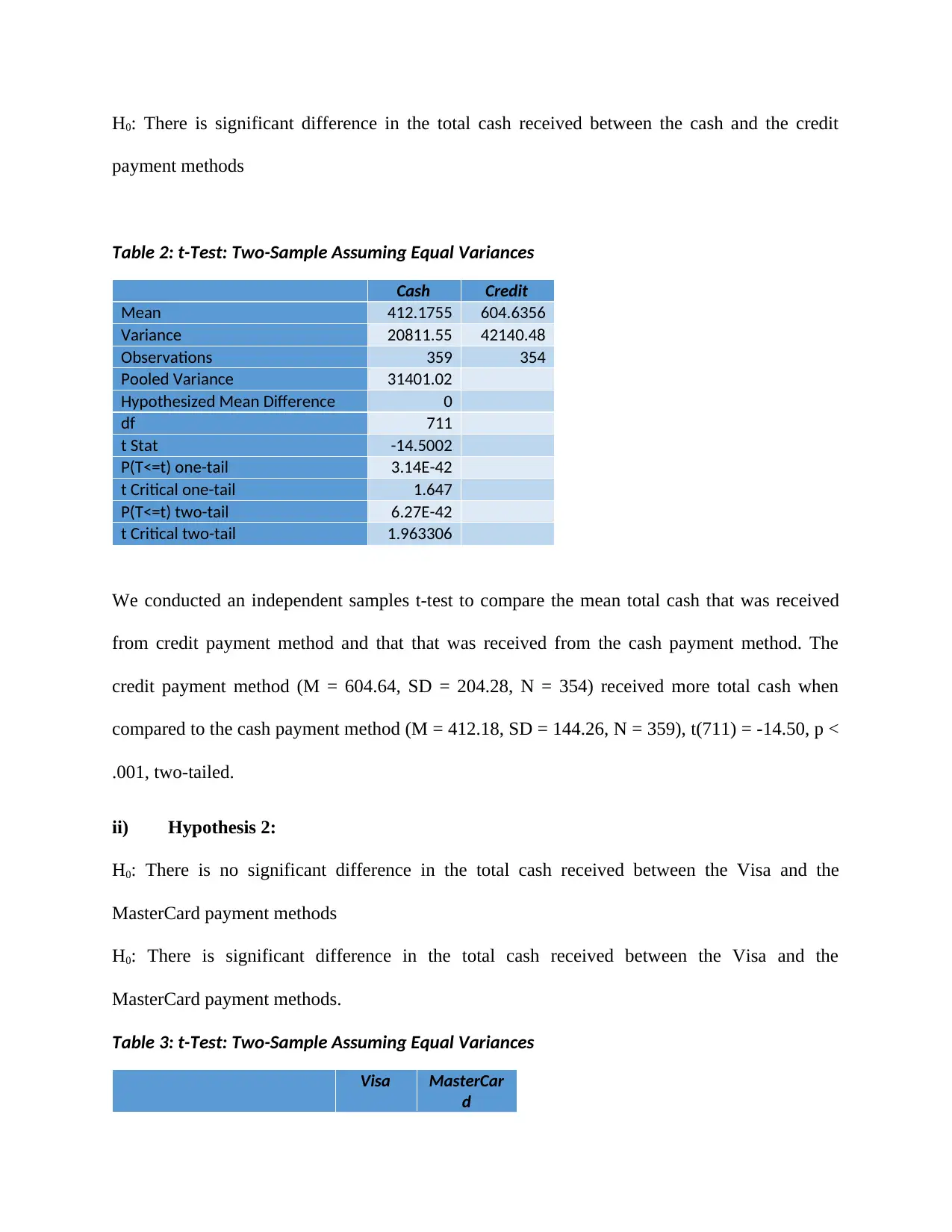
H0: There is significant difference in the total cash received between the cash and the credit
payment methods
Table 2: t-Test: Two-Sample Assuming Equal Variances
Cash Credit
Mean 412.1755 604.6356
Variance 20811.55 42140.48
Observations 359 354
Pooled Variance 31401.02
Hypothesized Mean Difference 0
df 711
t Stat -14.5002
P(T<=t) one-tail 3.14E-42
t Critical one-tail 1.647
P(T<=t) two-tail 6.27E-42
t Critical two-tail 1.963306
We conducted an independent samples t-test to compare the mean total cash that was received
from credit payment method and that that was received from the cash payment method. The
credit payment method (M = 604.64, SD = 204.28, N = 354) received more total cash when
compared to the cash payment method (M = 412.18, SD = 144.26, N = 359), t(711) = -14.50, p <
.001, two-tailed.
ii) Hypothesis 2:
H0: There is no significant difference in the total cash received between the Visa and the
MasterCard payment methods
H0: There is significant difference in the total cash received between the Visa and the
MasterCard payment methods.
Table 3: t-Test: Two-Sample Assuming Equal Variances
Visa MasterCar
d
payment methods
Table 2: t-Test: Two-Sample Assuming Equal Variances
Cash Credit
Mean 412.1755 604.6356
Variance 20811.55 42140.48
Observations 359 354
Pooled Variance 31401.02
Hypothesized Mean Difference 0
df 711
t Stat -14.5002
P(T<=t) one-tail 3.14E-42
t Critical one-tail 1.647
P(T<=t) two-tail 6.27E-42
t Critical two-tail 1.963306
We conducted an independent samples t-test to compare the mean total cash that was received
from credit payment method and that that was received from the cash payment method. The
credit payment method (M = 604.64, SD = 204.28, N = 354) received more total cash when
compared to the cash payment method (M = 412.18, SD = 144.26, N = 359), t(711) = -14.50, p <
.001, two-tailed.
ii) Hypothesis 2:
H0: There is no significant difference in the total cash received between the Visa and the
MasterCard payment methods
H0: There is significant difference in the total cash received between the Visa and the
MasterCard payment methods.
Table 3: t-Test: Two-Sample Assuming Equal Variances
Visa MasterCar
d
Paraphrase This Document
Need a fresh take? Get an instant paraphrase of this document with our AI Paraphraser
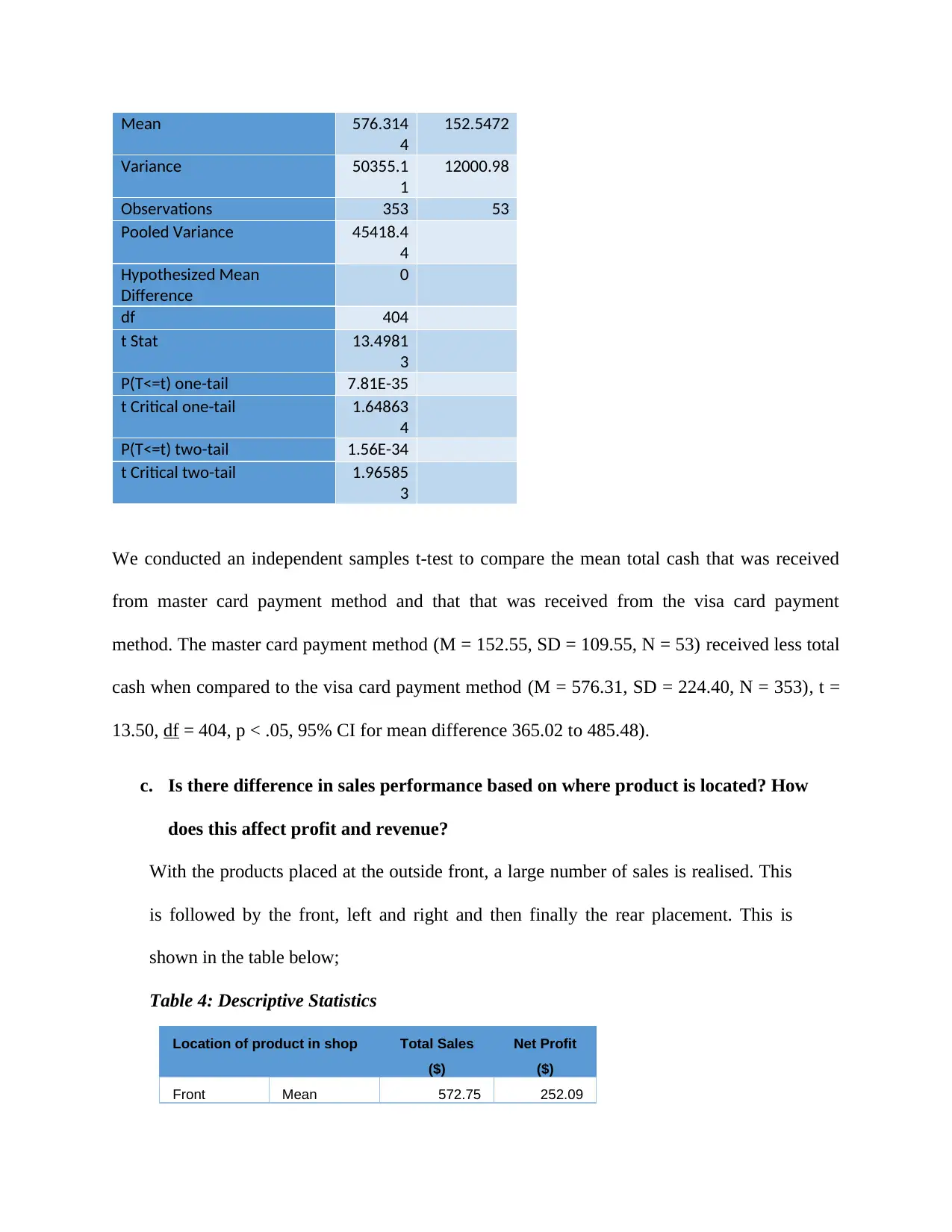
Mean 576.314
4
152.5472
Variance 50355.1
1
12000.98
Observations 353 53
Pooled Variance 45418.4
4
Hypothesized Mean
Difference
0
df 404
t Stat 13.4981
3
P(T<=t) one-tail 7.81E-35
t Critical one-tail 1.64863
4
P(T<=t) two-tail 1.56E-34
t Critical two-tail 1.96585
3
We conducted an independent samples t-test to compare the mean total cash that was received
from master card payment method and that that was received from the visa card payment
method. The master card payment method (M = 152.55, SD = 109.55, N = 53) received less total
cash when compared to the visa card payment method (M = 576.31, SD = 224.40, N = 353), t =
13.50, df = 404, p < .05, 95% CI for mean difference 365.02 to 485.48).
c. Is there difference in sales performance based on where product is located? How
does this affect profit and revenue?
With the products placed at the outside front, a large number of sales is realised. This
is followed by the front, left and right and then finally the rear placement. This is
shown in the table below;
Table 4: Descriptive Statistics
Location of product in shop Total Sales
($)
Net Profit
($)
Front Mean 572.75 252.09
4
152.5472
Variance 50355.1
1
12000.98
Observations 353 53
Pooled Variance 45418.4
4
Hypothesized Mean
Difference
0
df 404
t Stat 13.4981
3
P(T<=t) one-tail 7.81E-35
t Critical one-tail 1.64863
4
P(T<=t) two-tail 1.56E-34
t Critical two-tail 1.96585
3
We conducted an independent samples t-test to compare the mean total cash that was received
from master card payment method and that that was received from the visa card payment
method. The master card payment method (M = 152.55, SD = 109.55, N = 53) received less total
cash when compared to the visa card payment method (M = 576.31, SD = 224.40, N = 353), t =
13.50, df = 404, p < .05, 95% CI for mean difference 365.02 to 485.48).
c. Is there difference in sales performance based on where product is located? How
does this affect profit and revenue?
With the products placed at the outside front, a large number of sales is realised. This
is followed by the front, left and right and then finally the rear placement. This is
shown in the table below;
Table 4: Descriptive Statistics
Location of product in shop Total Sales
($)
Net Profit
($)
Front Mean 572.75 252.09
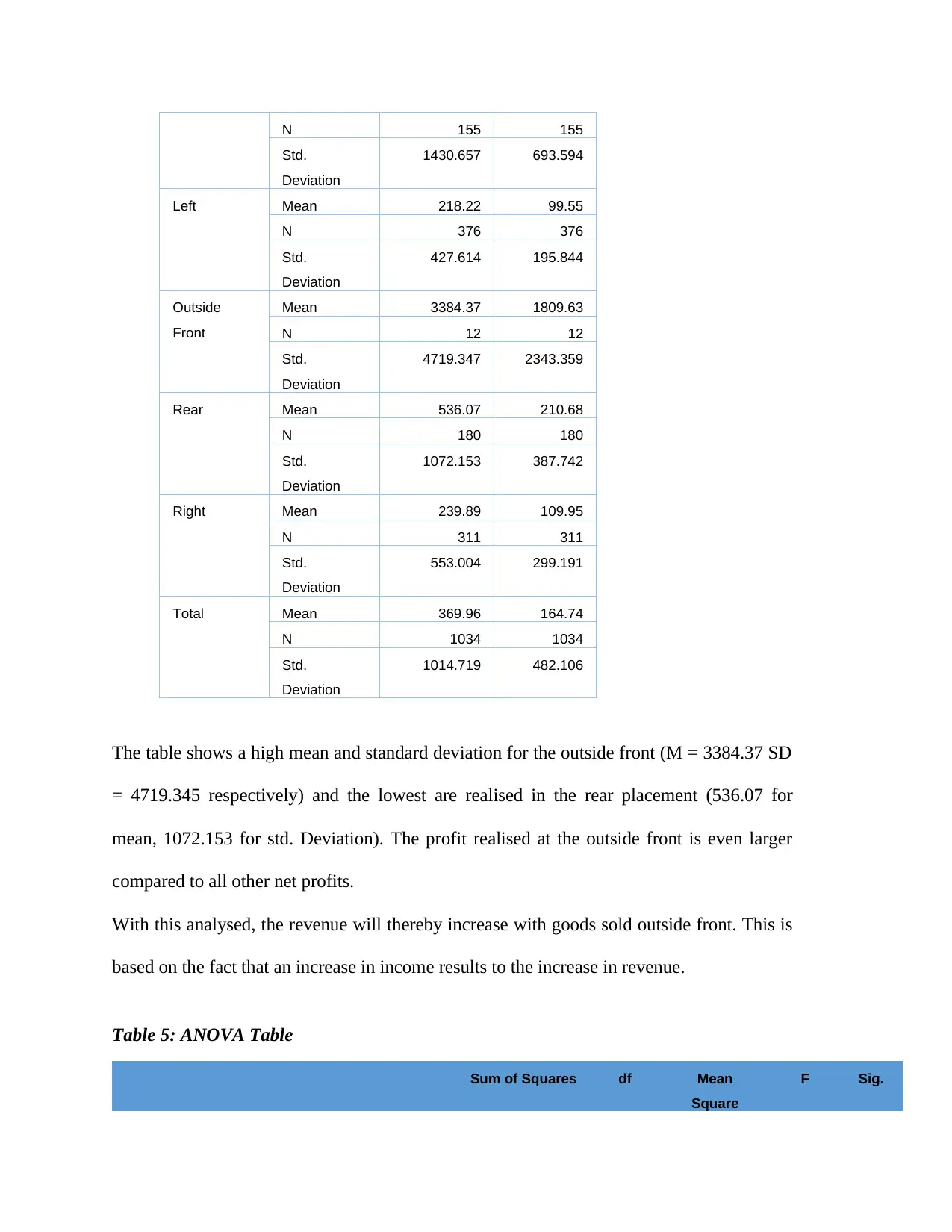
N 155 155
Std.
Deviation
1430.657 693.594
Left Mean 218.22 99.55
N 376 376
Std.
Deviation
427.614 195.844
Outside
Front
Mean 3384.37 1809.63
N 12 12
Std.
Deviation
4719.347 2343.359
Rear Mean 536.07 210.68
N 180 180
Std.
Deviation
1072.153 387.742
Right Mean 239.89 109.95
N 311 311
Std.
Deviation
553.004 299.191
Total Mean 369.96 164.74
N 1034 1034
Std.
Deviation
1014.719 482.106
The table shows a high mean and standard deviation for the outside front (M = 3384.37 SD
= 4719.345 respectively) and the lowest are realised in the rear placement (536.07 for
mean, 1072.153 for std. Deviation). The profit realised at the outside front is even larger
compared to all other net profits.
With this analysed, the revenue will thereby increase with goods sold outside front. This is
based on the fact that an increase in income results to the increase in revenue.
Table 5: ANOVA Table
Sum of Squares df Mean
Square
F Sig.
Std.
Deviation
1430.657 693.594
Left Mean 218.22 99.55
N 376 376
Std.
Deviation
427.614 195.844
Outside
Front
Mean 3384.37 1809.63
N 12 12
Std.
Deviation
4719.347 2343.359
Rear Mean 536.07 210.68
N 180 180
Std.
Deviation
1072.153 387.742
Right Mean 239.89 109.95
N 311 311
Std.
Deviation
553.004 299.191
Total Mean 369.96 164.74
N 1034 1034
Std.
Deviation
1014.719 482.106
The table shows a high mean and standard deviation for the outside front (M = 3384.37 SD
= 4719.345 respectively) and the lowest are realised in the rear placement (536.07 for
mean, 1072.153 for std. Deviation). The profit realised at the outside front is even larger
compared to all other net profits.
With this analysed, the revenue will thereby increase with goods sold outside front. This is
based on the fact that an increase in income results to the increase in revenue.
Table 5: ANOVA Table
Sum of Squares df Mean
Square
F Sig.
⊘ This is a preview!⊘
Do you want full access?
Subscribe today to unlock all pages.

Trusted by 1+ million students worldwide
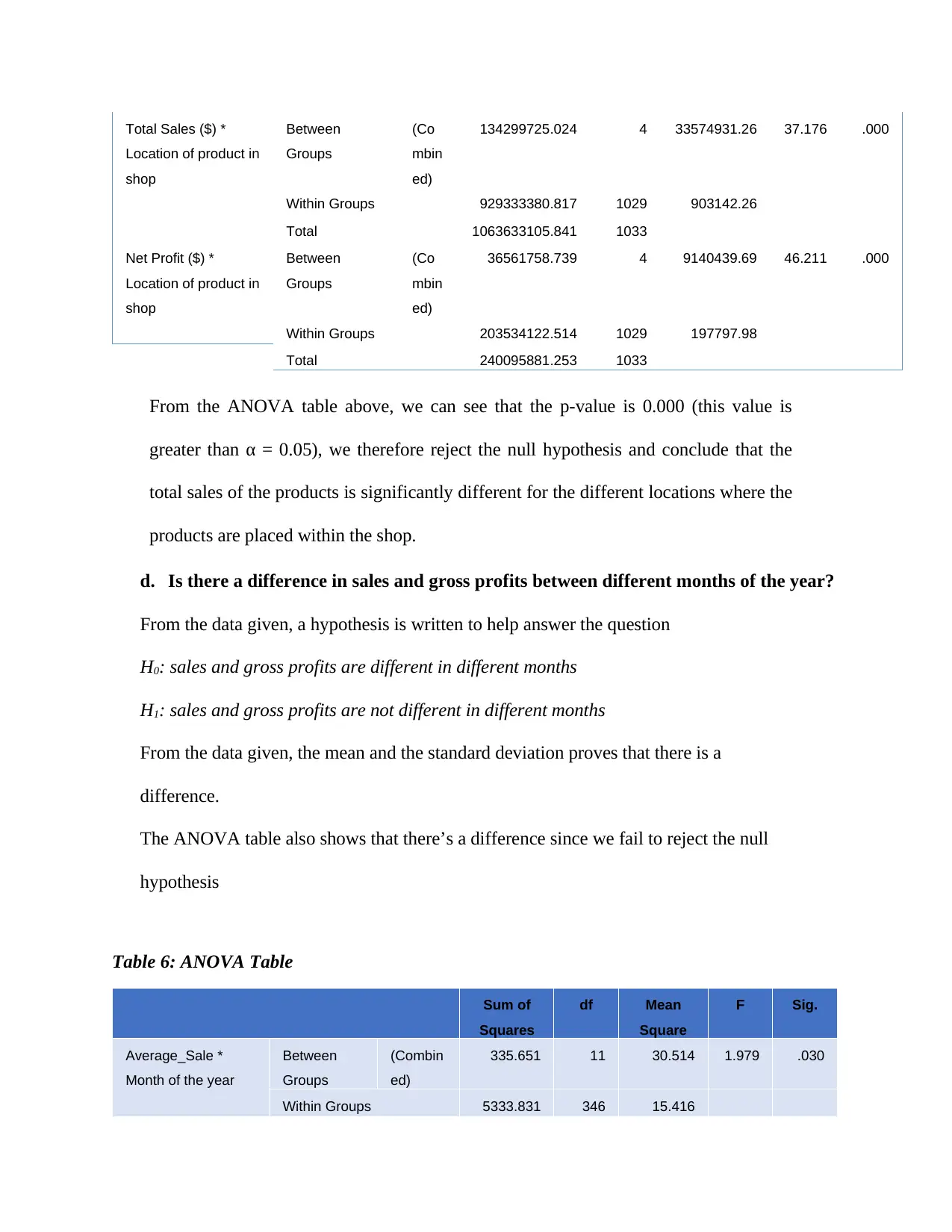
Total Sales ($) *
Location of product in
shop
Between
Groups
(Co
mbin
ed)
134299725.024 4 33574931.26 37.176 .000
Within Groups 929333380.817 1029 903142.26
Total 1063633105.841 1033
Net Profit ($) *
Location of product in
shop
Between
Groups
(Co
mbin
ed)
36561758.739 4 9140439.69 46.211 .000
Within Groups 203534122.514 1029 197797.98
Total 240095881.253 1033
From the ANOVA table above, we can see that the p-value is 0.000 (this value is
greater than α = 0.05), we therefore reject the null hypothesis and conclude that the
total sales of the products is significantly different for the different locations where the
products are placed within the shop.
d. Is there a difference in sales and gross profits between different months of the year?
From the data given, a hypothesis is written to help answer the question
H0: sales and gross profits are different in different months
H1: sales and gross profits are not different in different months
From the data given, the mean and the standard deviation proves that there is a
difference.
The ANOVA table also shows that there’s a difference since we fail to reject the null
hypothesis
Table 6: ANOVA Table
Sum of
Squares
df Mean
Square
F Sig.
Average_Sale *
Month of the year
Between
Groups
(Combin
ed)
335.651 11 30.514 1.979 .030
Within Groups 5333.831 346 15.416
Location of product in
shop
Between
Groups
(Co
mbin
ed)
134299725.024 4 33574931.26 37.176 .000
Within Groups 929333380.817 1029 903142.26
Total 1063633105.841 1033
Net Profit ($) *
Location of product in
shop
Between
Groups
(Co
mbin
ed)
36561758.739 4 9140439.69 46.211 .000
Within Groups 203534122.514 1029 197797.98
Total 240095881.253 1033
From the ANOVA table above, we can see that the p-value is 0.000 (this value is
greater than α = 0.05), we therefore reject the null hypothesis and conclude that the
total sales of the products is significantly different for the different locations where the
products are placed within the shop.
d. Is there a difference in sales and gross profits between different months of the year?
From the data given, a hypothesis is written to help answer the question
H0: sales and gross profits are different in different months
H1: sales and gross profits are not different in different months
From the data given, the mean and the standard deviation proves that there is a
difference.
The ANOVA table also shows that there’s a difference since we fail to reject the null
hypothesis
Table 6: ANOVA Table
Sum of
Squares
df Mean
Square
F Sig.
Average_Sale *
Month of the year
Between
Groups
(Combin
ed)
335.651 11 30.514 1.979 .030
Within Groups 5333.831 346 15.416
Paraphrase This Document
Need a fresh take? Get an instant paraphrase of this document with our AI Paraphraser
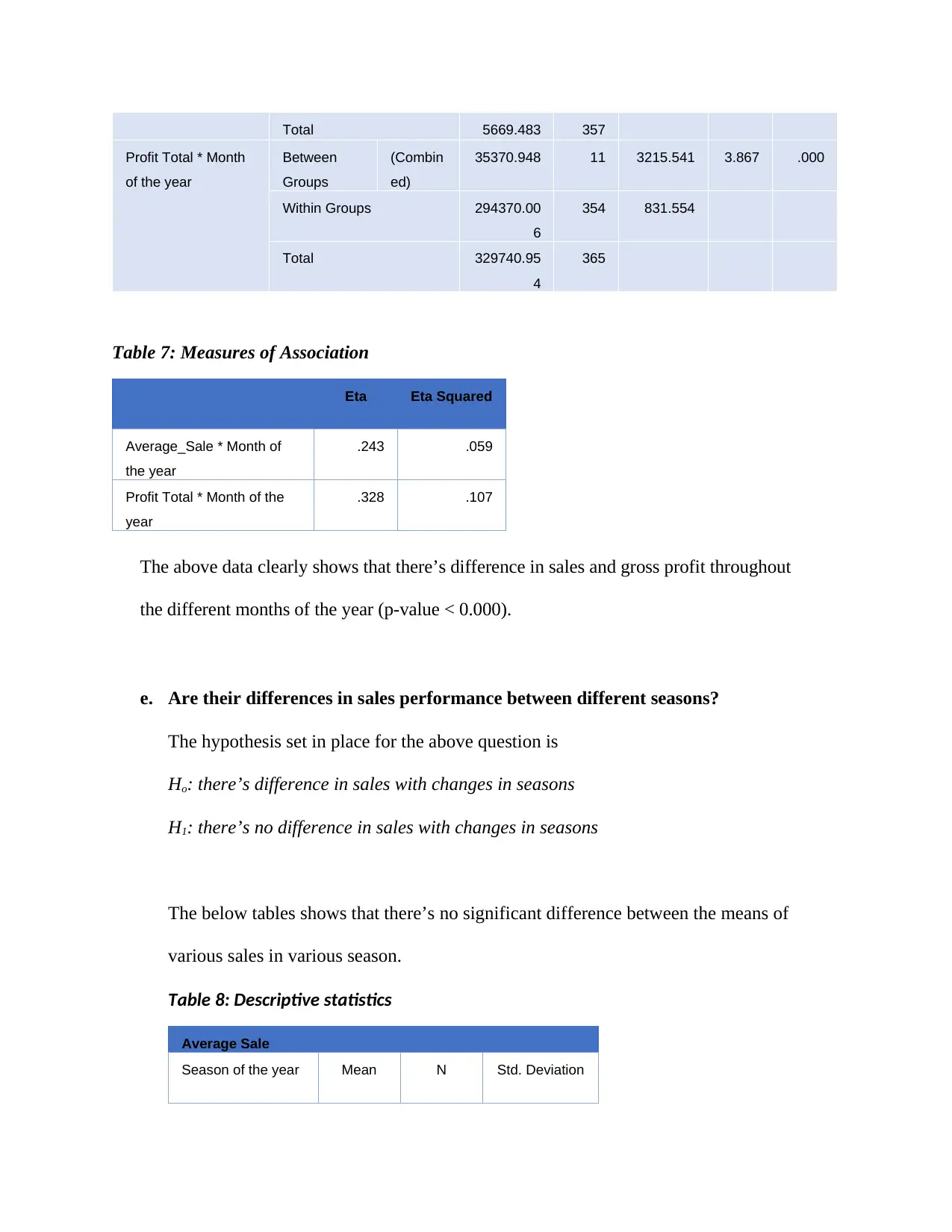
Total 5669.483 357
Profit Total * Month
of the year
Between
Groups
(Combin
ed)
35370.948 11 3215.541 3.867 .000
Within Groups 294370.00
6
354 831.554
Total 329740.95
4
365
Table 7: Measures of Association
Eta Eta Squared
Average_Sale * Month of
the year
.243 .059
Profit Total * Month of the
year
.328 .107
The above data clearly shows that there’s difference in sales and gross profit throughout
the different months of the year (p-value < 0.000).
e. Are their differences in sales performance between different seasons?
The hypothesis set in place for the above question is
Ho: there’s difference in sales with changes in seasons
H1: there’s no difference in sales with changes in seasons
The below tables shows that there’s no significant difference between the means of
various sales in various season.
Table 8: Descriptive statistics
Average Sale
Season of the year Mean N Std. Deviation
Profit Total * Month
of the year
Between
Groups
(Combin
ed)
35370.948 11 3215.541 3.867 .000
Within Groups 294370.00
6
354 831.554
Total 329740.95
4
365
Table 7: Measures of Association
Eta Eta Squared
Average_Sale * Month of
the year
.243 .059
Profit Total * Month of the
year
.328 .107
The above data clearly shows that there’s difference in sales and gross profit throughout
the different months of the year (p-value < 0.000).
e. Are their differences in sales performance between different seasons?
The hypothesis set in place for the above question is
Ho: there’s difference in sales with changes in seasons
H1: there’s no difference in sales with changes in seasons
The below tables shows that there’s no significant difference between the means of
various sales in various season.
Table 8: Descriptive statistics
Average Sale
Season of the year Mean N Std. Deviation
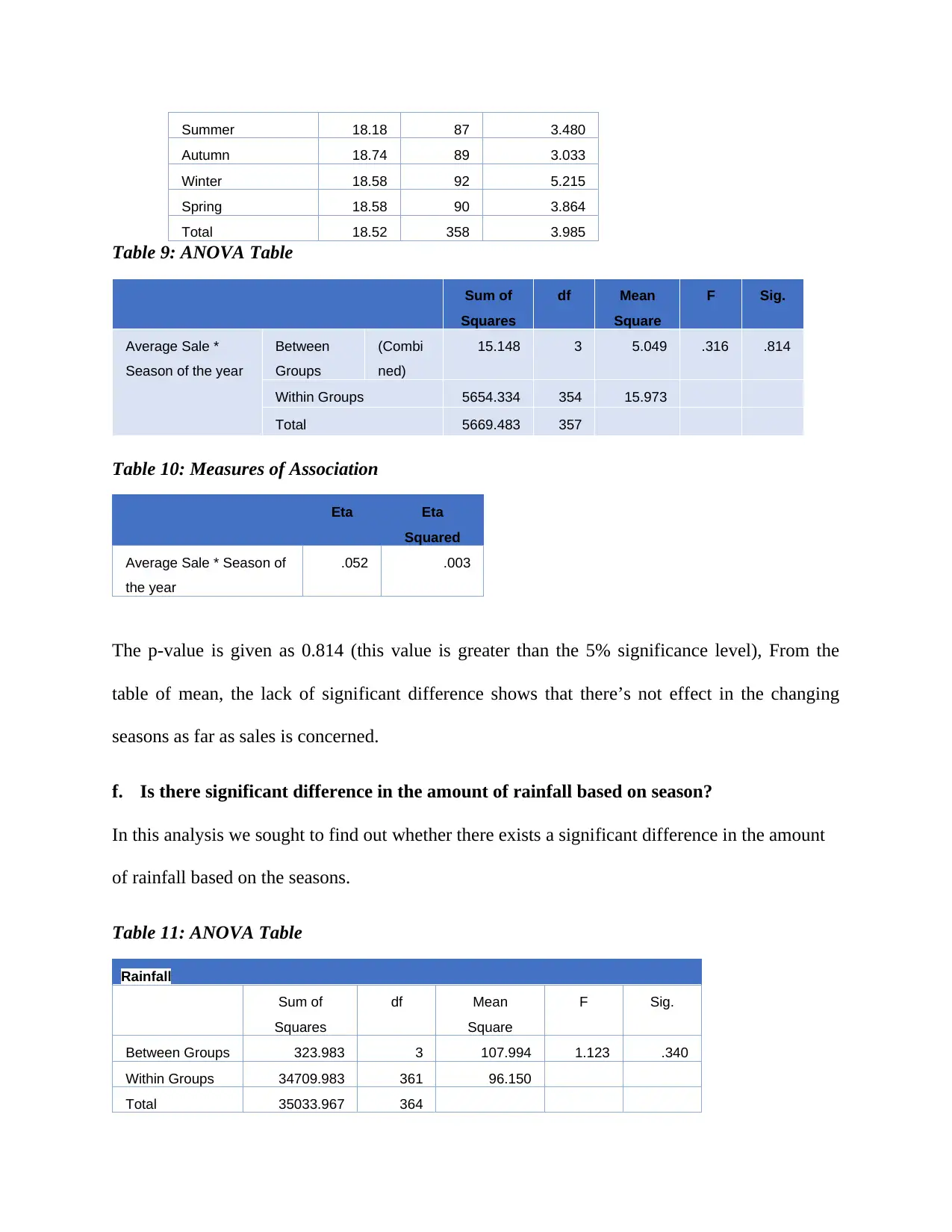
Summer 18.18 87 3.480
Autumn 18.74 89 3.033
Winter 18.58 92 5.215
Spring 18.58 90 3.864
Total 18.52 358 3.985
Table 9: ANOVA Table
Sum of
Squares
df Mean
Square
F Sig.
Average Sale *
Season of the year
Between
Groups
(Combi
ned)
15.148 3 5.049 .316 .814
Within Groups 5654.334 354 15.973
Total 5669.483 357
Table 10: Measures of Association
Eta Eta
Squared
Average Sale * Season of
the year
.052 .003
The p-value is given as 0.814 (this value is greater than the 5% significance level), From the
table of mean, the lack of significant difference shows that there’s not effect in the changing
seasons as far as sales is concerned.
f. Is there significant difference in the amount of rainfall based on season?
In this analysis we sought to find out whether there exists a significant difference in the amount
of rainfall based on the seasons.
Table 11: ANOVA Table
Rainfall
Sum of
Squares
df Mean
Square
F Sig.
Between Groups 323.983 3 107.994 1.123 .340
Within Groups 34709.983 361 96.150
Total 35033.967 364
Autumn 18.74 89 3.033
Winter 18.58 92 5.215
Spring 18.58 90 3.864
Total 18.52 358 3.985
Table 9: ANOVA Table
Sum of
Squares
df Mean
Square
F Sig.
Average Sale *
Season of the year
Between
Groups
(Combi
ned)
15.148 3 5.049 .316 .814
Within Groups 5654.334 354 15.973
Total 5669.483 357
Table 10: Measures of Association
Eta Eta
Squared
Average Sale * Season of
the year
.052 .003
The p-value is given as 0.814 (this value is greater than the 5% significance level), From the
table of mean, the lack of significant difference shows that there’s not effect in the changing
seasons as far as sales is concerned.
f. Is there significant difference in the amount of rainfall based on season?
In this analysis we sought to find out whether there exists a significant difference in the amount
of rainfall based on the seasons.
Table 11: ANOVA Table
Rainfall
Sum of
Squares
df Mean
Square
F Sig.
Between Groups 323.983 3 107.994 1.123 .340
Within Groups 34709.983 361 96.150
Total 35033.967 364
⊘ This is a preview!⊘
Do you want full access?
Subscribe today to unlock all pages.

Trusted by 1+ million students worldwide
1 out of 17
Related Documents
Your All-in-One AI-Powered Toolkit for Academic Success.
+13062052269
info@desklib.com
Available 24*7 on WhatsApp / Email
![[object Object]](/_next/static/media/star-bottom.7253800d.svg)
Unlock your academic potential
Copyright © 2020–2025 A2Z Services. All Rights Reserved. Developed and managed by ZUCOL.





